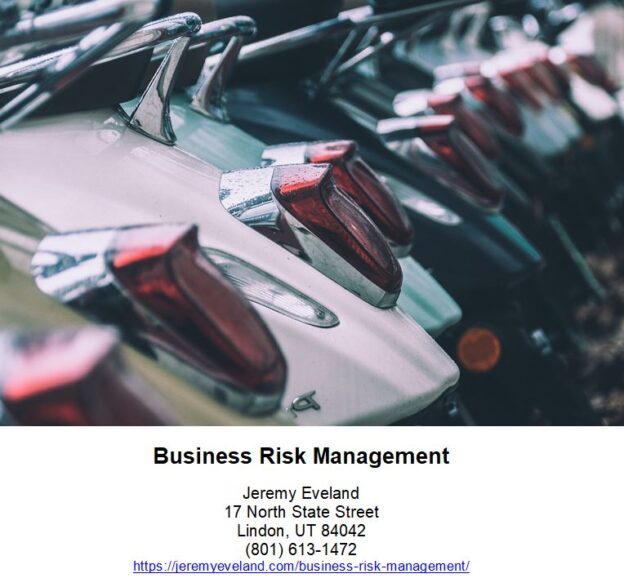In the world of commercial real estate, it’s essential to understand the legal responsibilities when it comes to natural disaster preparedness. From hurricanes to earthquakes, being proactive in protecting your property not only safeguards your investment but also ensures the safety of tenants and employees. In this article, we will explore the legal obligations that landlords and property owners have in the face of natural disasters, highlighting key considerations and strategies to mitigate potential risks at every step. By the end, you’ll be equipped with the knowledge to navigate the complex landscape of commercial real estate and be inspired to seek the expertise of a seasoned lawyer like Jeremy Eveland for further guidance.

Understanding the Legal Responsibilities of Commercial Real Estate Owners
The importance of natural disaster preparedness in commercial real estate
As a commercial real estate owner, it is crucial to understand the legal responsibilities that come with owning and managing properties, especially when it comes to natural disaster preparedness. Natural disasters such as hurricanes, earthquakes, floods, and fires can cause significant damage to buildings and infrastructure, resulting in financial losses, potential lawsuits, and even harm to tenants and visitors. Therefore, taking proactive steps to prepare for these events is not only a moral obligation but also a legal requirement.
Legal obligations of commercial real estate owners
Commercial real estate owners have certain legal obligations when it comes to natural disaster preparedness. These obligations can vary depending on local, state, and federal laws, as well as any contractual agreements with tenants. Generally, owners are responsible for maintaining a safe and secure environment for tenants and visitors, which includes ensuring that the property is well-maintained, structurally sound, and prepared for potential disasters.
Common legal issues arising from natural disasters
When natural disasters strike, they often bring about various legal issues that commercial real estate owners must navigate. Some common legal issues include insurance disputes, contract disputes with tenants, negligence claims, compliance with building codes and regulations, and liability for damages. Understanding these potential issues and having plans in place to address them is vital for mitigating legal risks and protecting your interests as a commercial real estate owner.
Preparing Commercial Real Estate for Natural Disasters
Risk assessment and mitigation strategies
Before a natural disaster occurs, it is essential for commercial real estate owners to conduct a thorough risk assessment of their properties. This assessment should identify potential hazards and vulnerabilities, such as proximity to flood zones or fault lines. Based on this assessment, owners can then develop and implement mitigation strategies to reduce risks and enhance the resilience of the property. This may involve retrofitting buildings, reinforcing structures, implementing drainage systems, or adopting other measures to minimize damage.
Business continuity planning
In addition to mitigating risks, commercial real estate owners should also develop comprehensive business continuity plans. These plans outline procedures to ensure the continued operation of the property and the safety of tenants and visitors during and after a natural disaster. This may include emergency evacuation protocols, backup power systems, communication strategies, and provisions for alternative locations in case of severe damage.
Structural improvements and safety measures
Maintaining the structural integrity of commercial properties is crucial for protecting against natural disasters. Regular inspections and proper maintenance should be conducted to identify and address any potential issues. Additionally, implementing safety measures such as fire suppression systems, emergency exits, and storm shelters can help minimize risks and ensure the well-being of occupants during emergencies.
Insurance considerations for natural disasters
Having adequate insurance coverage is vital for commercial real estate owners to protect their investments in the event of a natural disaster. It is important to review insurance policies regularly to ensure that they cover potential risks and losses associated with different types of natural disasters. Engaging with an experienced insurance professional can help owners understand their coverage needs and ensure they have appropriate policies in place.
Complying with Building Codes and Regulations
Understanding local, state, and federal building codes
Complying with building codes and regulations is essential for commercial real estate owners to ensure the safety and integrity of their properties. Building codes set specific standards for the design, construction, and maintenance of buildings to protect against various hazards, including natural disasters. Understanding and implementing these codes is crucial to avoid legal consequences and penalties.
Ensuring proper permits and approvals
Commercial real estate owners must obtain proper permits and approvals from local authorities before making any changes or improvements to their properties. This includes construction, renovations, or retrofitting projects aimed at enhancing the property’s resilience to natural disasters. Failing to obtain the necessary permits can result in legal violations and potential legal liabilities.
Regular inspections and maintenance
Regular inspections and ongoing maintenance are essential for commercial real estate owners to ensure compliance with building codes and regulations. These inspections help identify and address any issues or potential hazards promptly. Implementing a proactive maintenance plan can not only help prevent costly repairs but also reduce the risk of legal disputes related to negligence or non-compliance.
Liability for non-compliance
Failure to comply with building codes and regulations can result in legal liabilities for commercial real estate owners. In the event of a natural disaster, non-compliance may not only lead to increased property damage but also expose owners to lawsuits from tenants, visitors, or even government authorities. It is crucial to prioritize compliance and stay up to date with any changes or updates to the building codes and regulations applicable to your property.
Contractual Obligations and Responsibilities
Lease agreements and disaster recovery provisions
Lease agreements play a significant role in determining the rights and obligations of both commercial real estate owners and tenants during natural disasters. Including disaster recovery provisions in lease agreements can help establish clear expectations and responsibilities in the event of a disaster. These provisions may address issues such as rent abatement, property access, repairs, and temporary relocation.
Tenants’ rights and obligations during natural disasters
Tenants also have certain rights and obligations when it comes to natural disaster preparedness. Commercial real estate owners should communicate and educate tenants about emergency procedures, evacuation plans, and any specific protocols in place. Additionally, owners should be aware of tenant rights related to habitability, safety, and reasonable accommodations during and after a natural disaster.
Insurance requirements
Commercial real estate owners often require tenants to obtain their own insurance coverage, including coverage for potential natural disasters. Lease agreements should specify the types and amounts of insurance required, as well as any additional insured or waiver of subrogation requirements. Ensuring tenants have adequate insurance coverage can help protect both parties in the event of a disaster.
Negotiating force majeure clauses
Force majeure clauses in commercial lease agreements can provide protection for both owners and tenants in the event of unforeseen circumstances, such as natural disasters. These clauses typically define the rights and obligations of each party when a force majeure event occurs, including rent abatement, temporary suspension of obligations, or termination rights. Negotiating clear and comprehensive force majeure clauses can help mitigate potential disputes and provide certainty in uncertain situations.

Liability Issues and Negligence Claims
Duty of care towards tenants and visitors
Commercial real estate owners have a duty of care towards tenants and visitors to maintain a safe and secure environment. This duty includes taking reasonable steps to prevent foreseeable harm and addressing any potential hazards promptly. Failing to fulfill this duty of care can result in negligence claims in the event of a natural disaster.
Proving negligence in property maintenance
In the event of property damage or injuries during a natural disaster, tenants or visitors may file negligence claims against commercial real estate owners. Proving negligence typically involves demonstrating that the owner failed to fulfill their duty of care and that this failure directly caused or contributed to the damages or injuries. It is important for owners to maintain detailed records of property maintenance and repairs to defend against such claims.
Defending against liability claims
Being proactive in property maintenance, risk assessments, and disaster preparedness can help commercial real estate owners defend against liability claims. Adequate insurance coverage, compliance with building codes, and documented maintenance records are crucial in establishing a strong defense. Consulting with legal professionals experienced in liability claims can provide valuable guidance and support in mounting a successful defense.
Comparative negligence in natural disasters
In some jurisdictions, the concept of comparative negligence may apply to natural disasters. This means that if both the commercial real estate owner and the injured party are found to have contributed to the damages or injuries, liability may be apportioned based on the degree of fault. Understanding the principles of comparative negligence and how they may apply to natural disasters can help owners assess their potential liability and take appropriate precautions.
Environmental Considerations and Compliance
Assessing environmental risks in the vicinity
Commercial real estate owners must consider and assess environmental risks in the vicinity of their properties. This includes identifying potential sources of contamination or hazardous materials that may pose risks during natural disasters. Understanding the environmental hazards and implementing appropriate measures to mitigate those risks is crucial for both legal compliance and the safety of tenants and visitors.
Complying with environmental regulations
Commercial real estate owners have a legal obligation to comply with environmental regulations related to hazardous materials, waste management, and other environmental concerns. This includes obtaining necessary permits, conducting proper assessments, implementing appropriate mitigation measures, and ensuring proper disposal of hazardous materials. Failure to comply with environmental regulations can result in fines, penalties, and potential legal liabilities.
Managing hazardous materials and waste
Proper management of hazardous materials and waste is essential for commercial real estate owners to protect the environment and prevent potential harm to tenants, visitors, and surrounding communities. This may include implementing measures such as proper storage, labeling, handling, and disposal of hazardous materials. Having clear policies and procedures in place can help ensure compliance and minimize risks.
Remediation and cleanup responsibilities
In the aftermath of a natural disaster, commercial real estate owners may be responsible for the remediation and cleanup of any environmental contamination that occurred on their properties. This may involve hiring specialized contractors, coordinating with environmental agencies, and ensuring compliance with all necessary regulations. Timely and thorough remediation is crucial to protect the health and safety of all stakeholders and avoid legal consequences.
Emergency Preparedness and Response Planning
Developing a comprehensive emergency plan
Commercial real estate owners should develop a comprehensive emergency plan that outlines procedures and protocols for responding to natural disasters. This plan should include clear roles and responsibilities for staff, communication strategies, evacuation procedures, emergency contacts, and coordination with local emergency services. Regular training and drills should also be conducted to ensure everyone is prepared and aware of their roles during emergencies.
Establishing evacuation procedures
Having well-defined evacuation procedures is crucial for the safety of tenants, visitors, and staff during natural disasters. These procedures should include clear evacuation routes, assembly points, and communication protocols. Commercial real estate owners should collaborate with local emergency services to ensure that evacuation plans align with community-wide response efforts.
Collaborating with local emergency services
Collaborating with local emergency services is essential for effective disaster response and preparedness. Commercial real estate owners should establish relationships and open lines of communication with local fire departments, police departments, emergency management agencies, and other relevant entities. This collaboration can help owners stay informed about local emergency plans, receive guidance during emergencies, and facilitate a coordinated response.
Communicating with tenants and stakeholders
Open and transparent communication with tenants, stakeholders, and employees is key in disaster preparedness and response. Commercial real estate owners should proactively communicate emergency procedures, updates, and expectations to ensure everyone is well-informed and prepared. Providing resources, such as emergency contact information, safety guidelines, and regular updates, can help instill confidence and trust among all stakeholders.
Allocation of Costs and Losses
Determining responsibility for repair and reconstruction
In the aftermath of a natural disaster, commercial real estate owners may face the challenge of determining responsibility for repair and reconstruction. Lease agreements, insurance policies, and local laws may dictate the allocation of costs between the owner, tenants, and insurance providers. Clarifying these responsibilities and seeking legal counsel can help ensure a fair and efficient resolution.
Dispute resolution mechanisms
In the event of disagreements or disputes regarding the allocation of costs and losses after a natural disaster, commercial real estate owners should be familiar with available dispute resolution mechanisms. This may include mediation, arbitration, or litigation. Understanding these options and having provisions in lease agreements or other contractual documents can help streamline the resolution process and avoid prolonged legal battles.
Reimbursement for damages from insurance
Insurance coverage is a critical factor in the reimbursement of damages after a natural disaster. Commercial real estate owners should thoroughly understand their insurance policies, including any coverage exclusions or limitations related to natural disasters. Promptly documenting and reporting damages to insurance providers is essential to facilitate the claims process and seek reimbursement for the losses incurred.
Subrogation actions and recovery of losses
In the event that a third party is responsible for the damages caused by a natural disaster, commercial real estate owners may pursue subrogation actions to recover their losses. Subrogation allows the owner’s insurance provider to seek reimbursement from the responsible party or their insurance provider. Engaging legal professionals experienced in subrogation actions can help owners navigate the complexities of these claims and increase the likelihood of a successful recovery.

Government Assistance and Incentives
Federal and state disaster relief programs
In the aftermath of a natural disaster, commercial real estate owners may be eligible for assistance from federal and state government disaster relief programs. These programs provide financial aid, loans, tax incentives, and other resources to help owners recover and rebuild. Understanding the available programs, eligibility criteria, and application procedures is essential for accessing these resources in a timely manner.
Tax benefits and incentives for preparedness
Many jurisdictions provide tax benefits and incentives to commercial real estate owners who take proactive measures to prepare for natural disasters. These benefits may include tax credits, deductions, or exemptions for implementing safety measures, conducting risk assessments, or obtaining certain insurance coverages. Engaging with tax professionals knowledgeable in disaster-related incentives can help owners maximize their eligible benefits.
Public-private partnerships
Public-private partnerships can play a significant role in natural disaster preparedness and response. Commercial real estate owners can collaborate with local government agencies, emergency services, and community organizations to develop comprehensive disaster preparedness plans, share resources, and coordinate response efforts. Building strong partnerships can help leverage available resources and enhance the overall resilience of the community.
Navigating bureaucracy for assistance
Navigating government bureaucracy can be complex, especially during the chaotic aftermath of a natural disaster. Commercial real estate owners may face challenges in accessing available assistance and resources. Engaging legal professionals knowledgeable in disaster recovery and government assistance can help navigate the bureaucratic process, ensure compliance with requirements, and increase the chances of a successful application.
Seeking Legal Counsel for Natural Disaster Preparedness
The role of a commercial real estate lawyer
Commercial real estate lawyers play a crucial role in assisting owners with understanding and fulfilling their legal responsibilities regarding natural disaster preparedness. These lawyers can provide guidance on compliance with building codes and regulations, drafting and negotiating lease agreements, managing liability risks, and navigating insurance claims. Their expertise and experience can help owners protect their interests and minimize legal risks.
Benefits of consulting with legal professionals
Consulting with legal professionals specializing in commercial real estate and natural disaster preparedness offers numerous benefits. These professionals can assess specific risks and legal obligations, develop tailored strategies and plans, review and negotiate contracts, and provide ongoing guidance regarding compliance and legal updates. Their expertise can help owners effectively manage legal risks and ensure the long-term success of their properties.
How to choose the right legal representation
Choosing the right legal representation is crucial for commercial real estate owners looking to address their natural disaster preparedness legal needs. When selecting a lawyer, consider their experience and expertise in commercial real estate law, their track record in handling disaster-related cases, and their ability to effectively communicate and collaborate with clients. Schedule consultations with potential lawyers to discuss your specific needs and assess their suitability for your requirements.
Protecting the interests of commercial property owners
Ultimately, commercial real estate owners must prioritize natural disaster preparedness to protect their investments, tenants, and stakeholders. By understanding and fulfilling their legal responsibilities, engaging with appropriate professionals, and staying proactive in risk management and compliance, owners can safeguard their properties, mitigate legal risks, and navigate the challenges that natural disasters may bring.




